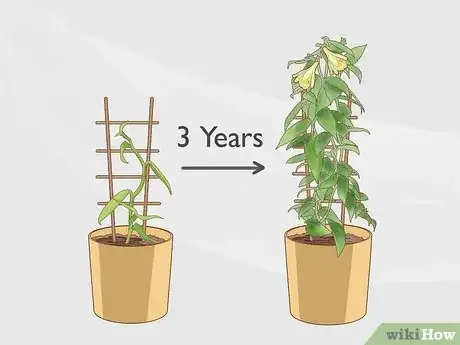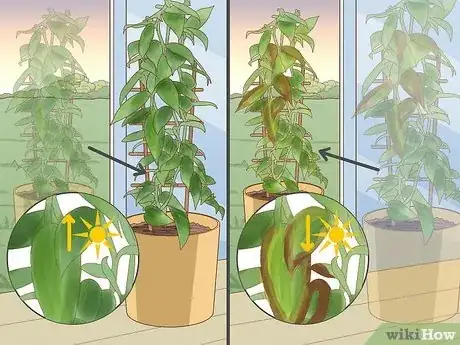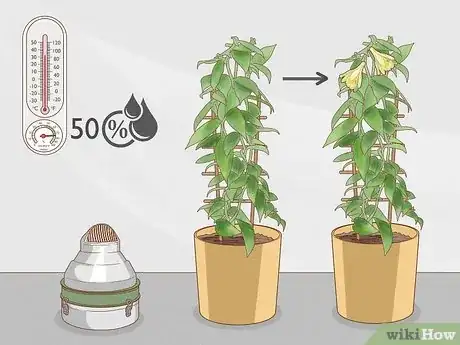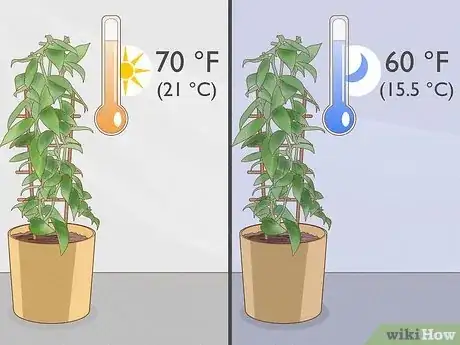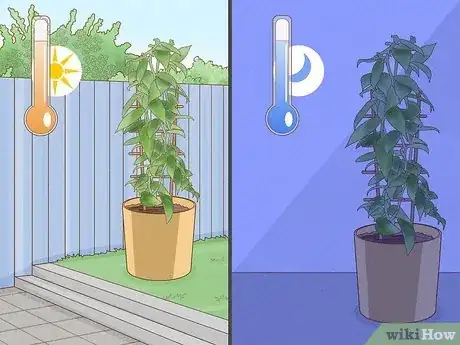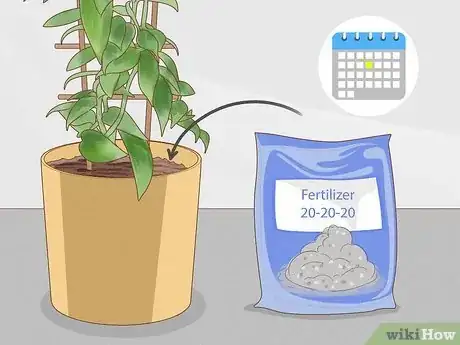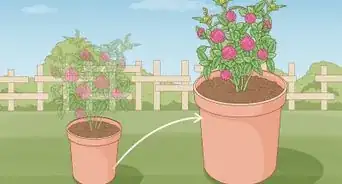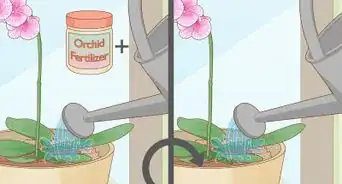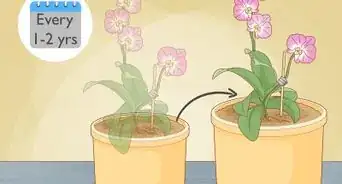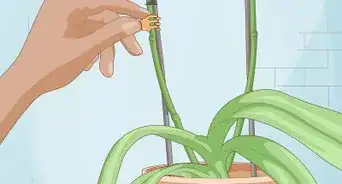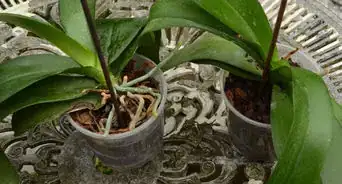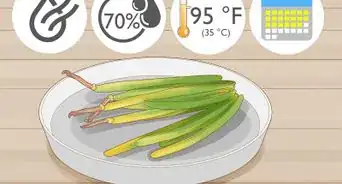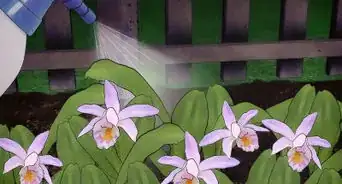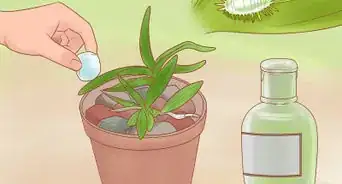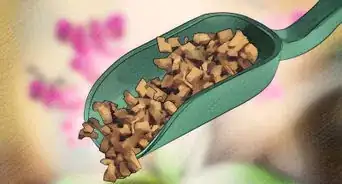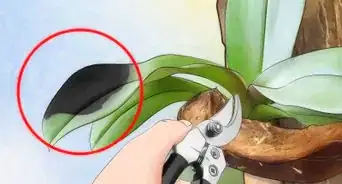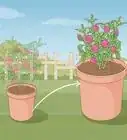X
wikiHow is a “wiki,” similar to Wikipedia, which means that many of our articles are co-written by multiple authors. To create this article, volunteer authors worked to edit and improve it over time.
This article has been viewed 36,791 times.
Learn more...
Vanilla orchids are made to bloom, so if yours isn't blooming, something may be wrong. These tropical plants have extremely specific water, fertilizer, sunlight, temperature, and humidity preferences. They won't bloom without them. Make the changes to the location of the plant, the feeding schedule or the environment to closely match what the plant needs, and beautiful green, blue, or white plants will be your reward.
Steps
-
1Try to determine the age of your orchid. Unfortunately, vanilla orchids cannot bloom until they are three years old. If yours is younger than three, it will not bloom and cannot be rushed.
-
2Look at the color of the orchid's leaves.
- If they are dark green, that means they are getting too much sun exposure. Move the plant to a less sunny area.
- If the leaves are yellow or even a brown color, this means that there is not enough sun exposure. Try moving it to a sunnier spot, such as a window ledge.
- If the leaves are a light green, that means there is a perfect amount of sunlight reaching it. The incorrect amount of sunlight can inhibit the blooming.
Advertisement -
3Measure the humidity of the air surrounding the plant using a humidity meter. Vanilla orchids require fifty percent humidity in order to bloom.
- If the air seems too dry, try placing the plant on a tray and fill the tray with water so that the air fills with humidity as the water evaporates. Top off the tray as often as needed, to ensure the tray has standing water in it at all times.
-
4Determine the temperature around your plant during day and nighttime hours with a thermometer. Orchids require a temperature of 70 °F (21 °C) during the day but allow a ten degree drop in the evening in order to bloom properly. Set your indoor temperature controls to make sure the temperature is set just right for proper blooming of your orchid plant.
-
5Make sure that the orchid gets sunlight during the day and darkness at night. This plays a huge role in the proper blooming of Vanilla orchids.
-
6Be sure to fertilize your orchid with 20-20-20 fertilizer once every month. Cut back on fertilization every six months when the orchid grows more slowly. Under-fertilization will result in no blooming at all or just a few small blooms.
Advertisement
Community Q&A
-
QuestionHow long does it take to get a vanilla bean>
 Jacob ForbesCommunity AnswerYou need to allow approximately 3-4 years after planting 8 nodes of a vanilla cutting before a flower will appear. The flower must be hand pollinated, usually by midday on the day that the flower appears (the flower last for only a few hours). The bean that results from that pollinated flower will mature in 9 months. The curing process takes 3-4 weeks, and then the bean is ready for use.
Jacob ForbesCommunity AnswerYou need to allow approximately 3-4 years after planting 8 nodes of a vanilla cutting before a flower will appear. The flower must be hand pollinated, usually by midday on the day that the flower appears (the flower last for only a few hours). The bean that results from that pollinated flower will mature in 9 months. The curing process takes 3-4 weeks, and then the bean is ready for use. -
QuestionWhat do I do if my orchid has many flowers, but I am not getting any beans?
 HarveyCommunity AnswerThis means that it is not being pollinated. Hand-pollinate the flower by using a toothpick or chopstick to gently brush together the male and female parts of the flower (the only natural pollinator of the vanilla orchid is a single bee species endemic to Mexico). The beans will mature in about 8-9 months, turning slightly yellow at one end.
HarveyCommunity AnswerThis means that it is not being pollinated. Hand-pollinate the flower by using a toothpick or chopstick to gently brush together the male and female parts of the flower (the only natural pollinator of the vanilla orchid is a single bee species endemic to Mexico). The beans will mature in about 8-9 months, turning slightly yellow at one end. -
QuestionWhat fertilizer is needed for my vanilla orchid plant?
 Community AnswerMany fertilizers may be used. A 20-20-20 fertilizer is fine; a fertilizer with nitrate nitrogen would be best, but not required. I would suggest the "weakly weekly" option when it comes to watering any orchid, accompanied by a monthly watering with no fertilizer (a flush). Use 1/5 to 1/4 the recommend amount through the growing season (late spring - early fall). Reduce the fertilizing frequency down to once a month or not at all through winter. If you're in the tropics, you may be able to fertilize year-round.
Community AnswerMany fertilizers may be used. A 20-20-20 fertilizer is fine; a fertilizer with nitrate nitrogen would be best, but not required. I would suggest the "weakly weekly" option when it comes to watering any orchid, accompanied by a monthly watering with no fertilizer (a flush). Use 1/5 to 1/4 the recommend amount through the growing season (late spring - early fall). Reduce the fertilizing frequency down to once a month or not at all through winter. If you're in the tropics, you may be able to fertilize year-round.
Advertisement
Things You'll Need
- 20-20-20 liquid fertilizer
- Quality watering can
- Room thermometer
- Humidity Gauge
- Humidity tray
About This Article
Advertisement
